 W
WThe Agasha Temple of Wisdom is a spiritualist group founded in 1943 by Richard Zenor. After the publication of James Crenshaw's book Telephone Between Two Worlds in 1950, in which both Zenor and the temple were prominently featured, the temple became more popular. Upon Zenor's death in 1978, Geary Salvat was chosen to lead the group.
 W
WAnecdotes of Oyasama, the Foundress of Tenrikyo is an anthology of anecdotes about Nakayama Miki, the foundress of Tenrikyo. This text is one of the supplemental texts to the Tenrikyo scriptures, along with The Doctrine of Tenrikyo and The Life of Oyasama.
 W
WThe Arabic Bayán is a book written by the Báb around 1848. Its larger sister book is the Persian Bayán. The work is incomplete, containing only eleven Vahids. Each Vahid serves as a chapter and contains nineteen Abwab. The grammar is highly irregular. The work was composed while the Báb was imprisoned in Maku, Iran.
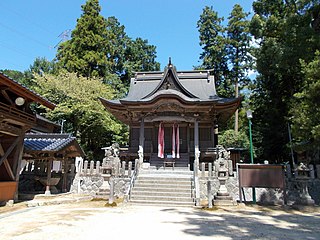 W
WAraho Shrine is a Shinto shrine located in Kiyama, Saga Prefecture, Japan.
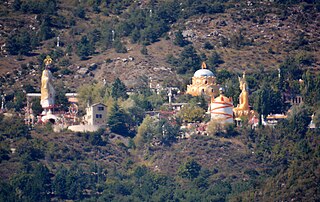 W
WAumism is a minor religious sect founded in 1969 by Gilbert Bourdin (1924-1998). Centered on the "holy city" of Mandarom, near Castellane in the French Alps, it has approximately 400 members, down from 1200 at its peak. It is a synthesis of a number of religions, notably buddhism. Its name derives from the mystical "aum" sound used in Hindu meditation.
 W
WAzizollah Khoshvaqt, also known as Ayatollah Khoshvaqt, was a contemporary philosopher, mystic, theologian and faqih. He was a student of Muhammad Husayn Tabatabai, Seyyed Hossein Borujerdi and Seyyed Ruhollah Khomeini. He was the second child of the family, went to seminary after passing high-school, and went to Qom after educating for five years in Lorzadeh mosque in Tehran.
 W
WBà Chúa Kho is a goddess of Vietnamese folk religion, with her temple in Bắc Ninh. She is one of the new popular goddess like Bà Chúa Xứ, Lady of the Realm.
 W
WIn Judaism, Christianity, and some other Abrahamic religions, the cultural mandate is the divine injunction found in Genesis 1:28, in which God, after having created the world and all in it, ascribes to humankind the tasks of filling, subduing, and ruling over the earth. The cultural mandate includes the sentence "Be fruitful and multiply and fill the Earth." The cultural mandate was given to Adam and Eve.
 W
WA boli is a fetish of the Bambara or Malinké of Mali.
 W
WBrainwash: The Secret History of Mind Control (ISBN 0-340-83161-8) is a 2006 non-fiction book published by Hodder & Stoughton about the evolution of mind control from its origins in the Cold War through to today's War on Terror. The author, Dominic Streatfeild, uses formerly classified documentation and interviews from the CIA, U.S. Army, MI5, MI6 and British Intelligence Corps to investigate the methods intended to destroy and reconstruct the minds of captives, to extract information and convert dissidents. Brainwash is Streatfeild's second book, following on from his 2002 book, Cocaine: An Unauthorised Biography.
 W
WA calaca is a figure of a skull or skeleton commonly used for decoration during the Mexican Day of the Dead festival, although they are made all year round.
 W
WCandomblé Jejé, also known as Brazilian Vodum, is one of the major branches (nations) of Candomblé. It developed in the Portuguese Empire among Fon and Ewe slaves. Jejé is a Yoruba word meaning stranger, which is what the Fon and Ewe slaves represented to the Yoruba slaves.
 W
WĐạo Mẫu is the worship of mother goddesses which was established in Vietnam in the 16th century. While scholars like Ngô Đức Thịnh propose that it represents a systematic mother goddess, Đạo Mẫu draws together fairly disparate beliefs and practices. These include the worship of goddesses such as Thiên Y A Na, The Lady of the Realm, The Lady of the Storehouse and Princess Liễu Hạnh, legendary figures like Âu Cơ, the Trưng Sisters, and Lady Triệu, as well as the branch Four Palaces.
 W
WDeconsecration, also called secularization, is the act of removing a religious blessing from something that had been previously consecrated by a minister or priest of that religion. The practice is usually performed on churches or synagogues to be rendered to non-religious (secular) use or demolished.
 W
WDivided City is a novel written by Theresa Breslin and published in 2005 by Doubleday. The novel is written for teenagers and adults concerning the problems of sectarianism in Glasgow and racism against asylum seekers.
 W
WA false god is, in some monotheistic religious denominations, the deities of pagan religions – as well as other competing entities or objects to which particular importance is attributed. Conversely, polytheistic pagans may regard the gods of various monotheistic religions as "false gods" because they do not believe that any real deity possesses the properties ascribed by monotheists to their sole deity. Atheists, who do not believe in any deities, do not usually use the term "false god" even though that would encompass all deities from the atheist viewpoint. Usage of this term is generally limited to theists, who believe in some deity or deities, but not in others.
 W
WA grave candle, grave lantern, death candle or a death lantern is a type of candle or lantern, which is lit in memory of the dead or to commemorate solemn events. The form of a lantern is commonly used in Christianity, whereas candles are more common in Judaism.
 W
WThe Center for Muslim-Jewish Engagement (CMJE) was a faith-based coalition whose stated mission was to "promote dialogue, understanding and grassroots, congregational and academic partnerships among the oldest and the newest of the Abrahamic faiths while generating a contemporary understanding in this understudied area and creating new tools for interfaith communities locally, nationally and beyond." The center closed in January 2012.
 W
WJesus the Splendour is the pre-existent aspect of Jesus in Manichaeism. He brings knowledge about the secrets of the past, the present and prophecy of the future on one hand, and the ability to differentiate between good and evil towards humanity, on the other. Accordingly, it is also Jesus who frees Adam and advises him to eat from the Tree of knowledge to escape the prison of the Prince of Darkness.
 W
WIn the Tenrikyo religion, the Jiba (ぢば) is the axis mundi where adherents believe that God created humankind. The spot is located in the center of the main sanctuary at Tenrikyo Church Headquarters, located in Tenri, Nara, Japan. It is marked by a wooden pillar called the Kanrodai (かんろだい).
 W
WThe Lama of the Tamang people, is an ancient priestly clan having resided in the area now known as Nepal since antiquity and predating the spread of Buddhism, is associated with spiritual and religious dealings, including ancestor worship Additionally, other Swagen Bhai perform priestly rituals, such as shaman Jhankris, but the Lama are most associated with priesthood.
 W
WLay preacher is a preacher or a religious proclaimer who is not a formally ordained cleric. Lay preaching varies in importance between religions and their sects. Although Lay Preachers in many Christian denominations may be accorded titles such as Reverend as a courtesy by people - including those in their congregation - it is only once a priest, cleric, minister or reverend has been ordained that he/she can correctly adopt that title.
 W
WMacranthropy is the allegorical portrayal of the universe as a giant anthropomorphic body with the various components of the universe assigned to corresponding body parts.
 W
WMadhwanama is a special song on Madhvacharya which is written by Sripadaraja.
 W
WMartial temples, also translated as military temples or warrior temples, are Chinese temples dedicated to worshiping outstanding military leaders and strategists. They were often built by the governments as the counterpart of civil temples (wenmiao) or Temple of Confucius. Temples that worshiped both civil and military gods are called Wenwu temple (wenwumiao).
 W
WMeggen Lawn Cross is a supposedly supernatural mark of a cross in the ground in Meggen, a village near Argenbühl in Baden-Württemberg, Germany. The Cross first appeared on June 30, 1972 in form of a bald spot in the surrounding field. Later a cross with a length of 3.3 metres and a width of 1.6 metres appeared. The cross reappears each year. Its origin is unknown. Investigations by the University of Hohenheim have been unable to find any cause for the phenomenon.
 W
WMulticonfessional countries have a power sharing arrangement between people of different faiths, usually three or more significant confessional groups within the same jurisdiction. Examples of modern countries deemed multiconfessional are Lebanon and Bosnia and Herzegovina.
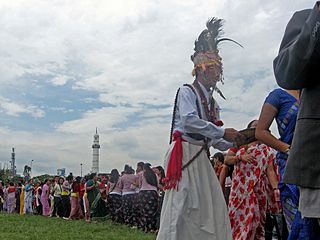 W
WNakchhong (नाक्छोङ) are priests of the Kirati people, an ethnic group that is predominantly located in the Himalayas.
 W
WThe Purépecha religion is the religion of the Purépecha people.
 W
WReligion in Barbados is predominantly Christian. Religious freedom is established by law and generally enforced in practice, although some minority religious groups have complaints about government practices that interfere with their beliefs.
 W
WThe most common religion in Dominica is Christianity, with a majority of practitioners identifying as Roman Catholic. Various minority religious groups are also present on the island.
 W
WReligion in Korea refers to the various religious traditions practiced on the Korean peninsula. The oldest indigenous religion of Korea is the Korean folk religion, which has been passed down from prehistory to the present. Buddhism was introduced to Korea from China during the Three Kingdoms era in the 4th century, and the religion pervaded the culture until the Joseon Dynasty, when Confucianism was established as the state philosophy. During the Late Joseon Dynasty, in the 19th century, Christianity began to gain a foothold in Korea. While both Christianity and Buddhism would play important roles in the resistance to the Japanese occupation of Korea in the first half of the 20th century, only about 4% of Koreans were members of a religious organization in 1940.
 W
WReligion in North America spans the period of Native American dwelling, European settlement, and the present day. Its various faiths have been a major influence on art, culture, philosophy and law.
 W
WReligion on the Falkland Islands is predominantly Christianity, of which the primary denominations are Church of England, Roman Catholic, United Free Church, and Lutheran. In the 2006 census most islanders identified themselves as Christian, followed by those who refused to answer or had no religious affiliation. The remaining 1.3 percent were adherents of other faiths.
 W
WReligion in the Faroe Islands consists largely of the Lutheran Church of the Faroe Islands, but also includes smaller Protestant groups such as the Open Brethren, as well as a few Catholics and adherents of non-Trinitarian religions, such as the Jehovah's Witnesses.
 W
WPridnestrovian Moldavian Republic (Transnistria) official statistics show that 91 percent of the Transnistrian population adhere to Eastern Orthodox Christianity, with 4 percent adhering to the Catholic Church. Roman Catholics are mainly located in Northern Transnistria, where a notable Polish minority is living.
 W
WReligion News Service (RNS) is a news agency covering religion, ethics, spirituality and moral issues. RNS employs a network of correspondents providing news and information on all faiths and religious movements to newspapers, magazines, broadcast organizations and religious publications. It also features commentary by Richard Mouw, Thomas J. Reese, Jana Riess, Mark Silk and other columnists, and offers a press release distribution service. RNS wire reports are distributed to secular and faith-based news outlets alike, including The Washington Post, USA Today, Christian Century and Sojourners.
 W
WA religious goods store or religious supplies shop is a store specializing in supplying materials used in the practice of Chinese folk religion, Taoism and Chinese Buddhism.
 W
WA religious or sacred precinct is the area around a religious site, such as a temple, that is dedicated to religious purposes. A religious precinct may be defined by a physical enclosure, although this is not always the case. Religious precincts are an aspect of the spatiality of religion.
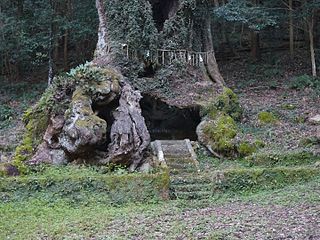 W
WA sacred tree is a tree which is considered to be sacred. They featured in, for example, the ancient Greek, Hindu mythology, Celtic and Germanic mythologies. They continue to hold profound meaning in Shinto, religion in China, and Akan people, among other institutions. Groups are known as sacred groves.
 W
WSipapu is a Hopi word for a small hole or indentation in the floor of a kiva or pithouse. Kivas were used by the Ancestral Puebloans and continue to be used by modern-day Puebloans. The sipapu symbolizes the portal through which their ancient ancestors first emerged to enter the present world.
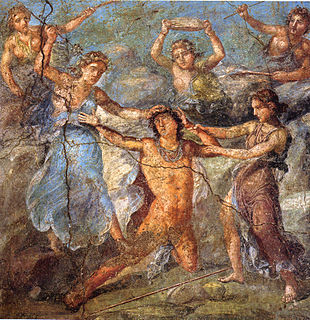 W
WSparagmos is an act of rending, tearing apart, or mangling, usually in a Dionysian context.
 W
WTrinidad Orisha, also known as Shango, is a syncretic religion in Trinidad and Tobago and is of Caribbean origin, originally from West Africa. Trinidad Orisha incorporates elements of Spiritual Baptism, and the closeness between Orisha and Spiritual Baptism has led to use of the term "Shango Baptist" to refer to members of either or both religions. Anthropologist James Houk described Trinidad Orisha as an "Afro-American religious complex", incorporating elements mainly of traditional African religion and Yoruba and incorporates some elements of Christianity, Hinduism, Islam, Buddhism, Judaism, Baháʼí, and Trinidad Kabbalah.
 W
WUtaki (御嶽) is an Okinawan term for a sacred place, often a grove, cave, or mountain. They are central to the Ryukyuan religion and the former noro priestess system. Although the term utaki is used throughout the Ryukyu Islands, the terms suku and on are heard in the Miyako and Yaeyama regions respectively. Utaki are usually located on the outskirts of villages and are places for the veneration of gods and ancestors. Most gusuku have places of worship, and it is theorized that the origins of both gusuku and utaki are closely related.